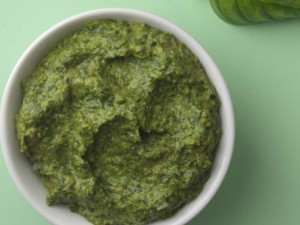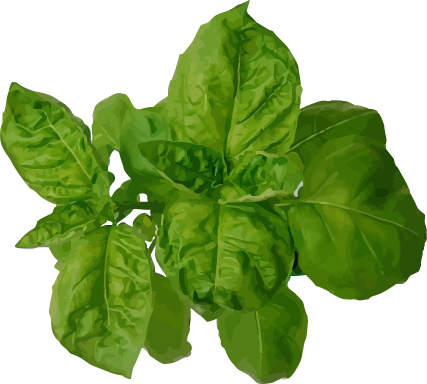On July 7, 1997, a company physician reported to the Alexandria Department of Health (ADOH) that most of the employees who attended a corporate luncheon on June 26 at the company’s branch in Fairfax, Virginia, had developed gastrointestinal illness. On July 11, the health department was notified that a stool specimen from one of the employees who attended the luncheon was positive for Cyclospora oocysts. Many others tested positive. It was subsequently revealed in a July 19, 1997, Washington Post story citing  local health department officials that basil and pesto from four Sutton Place Gourmet stores around Washington D.C. was the source of cyclospora for 126 people who attended at least 19 separate events where Sutton Place basil products were served, from small dinner parties and baby showers to corporate gatherings. Of the 126, 30 members of the National Symphony Orchestra became sick after they ate box lunches provided by Sutton Place at Wolf Trap Farm Park.
local health department officials that basil and pesto from four Sutton Place Gourmet stores around Washington D.C. was the source of cyclospora for 126 people who attended at least 19 separate events where Sutton Place basil products were served, from small dinner parties and baby showers to corporate gatherings. Of the 126, 30 members of the National Symphony Orchestra became sick after they ate box lunches provided by Sutton Place at Wolf Trap Farm Park.
In May 2001, 17 people in British Columbia were sickened with cyclospora associated with basil from Thailand. In 2005, 300 people in Florida were sickened with cyclospora from fresh basil.
My aunt was part of that outbreak.
Parasites. They’re everywhere.
Canadian researchers report in the Journal of Food Protection a “relatively high prevalence” of Cyclospora, Cryptosporidium and Giardia in ready-to-eat packaged leafy greens; most of the products were grown in the U.S.
Abstract below.
Detection of Cyclospora, Cryptosporidium, and Giardia in ready-to-eat packaged leafy greens in Ontario, Canada
Journal of Food Protection®, Number 2, February 2013, pp. 192-369 , pp. 307-313(7)
Dixon, Brent; Parrington, Lorna; Cook, Angela; Pollari, Frank; Farber, Jeffrey
http://www.ingentaconnect.com/content/iafp/jfp/2013/00000076/00000002/art00016
Numerous foodborne outbreaks of diarrheal illness associated with the consumption of produce contaminated with protozoan parasites have been reported in North America in recent years. The present study reports on the presence of Cyclospora, Cryptosporidium, and Giardia in precut salads and  leafy greens purchased at retail in Ontario, Canada. A total of 544 retail samples were collected between April 2009 and March 2010 and included a variety of salad blends and individual leafy greens. Most of these products were grown in the United States, with some from Canada and Mexico. Parasites were eluted and concentrated before detection by PCR and immunofluorescence microscopy. DNA sequences were aligned with reference sequences in GenBank. Cyclospora spp. were identified by PCR-restriction fragment length polymorphism in nine (1.7 % ) samples and by DNA sequence analysis. Cryptosporidium spp. were identified in 32 (5.9%) samples; 29 were sequenced and aligned with the zoonotic species Cryptosporidium parvum. Giardia duodenalis was identified in 10 (1.8%) samples, and of the 9 samples successfully sequenced, 7 aligned with G. duodenalis assemblage B and 2 with assemblage A, both of which are also zoonotic. The presence of Cryptosporidium oocysts and Giardia cysts was confirmed in some of the PCR-positive samples using microscopy, while Cyclospora -like oocysts were observed in most of the Cyclospora PCR-positive samples. The relatively high prevalence of these parasites in packaged salads and leafy greens establishes a baseline for further studies and suggests a need for additional research with respect to the possible sources of contamination of these foods, the determination of parasite viability and virulence, and means to reduce foodborne transmission to humans.
leafy greens purchased at retail in Ontario, Canada. A total of 544 retail samples were collected between April 2009 and March 2010 and included a variety of salad blends and individual leafy greens. Most of these products were grown in the United States, with some from Canada and Mexico. Parasites were eluted and concentrated before detection by PCR and immunofluorescence microscopy. DNA sequences were aligned with reference sequences in GenBank. Cyclospora spp. were identified by PCR-restriction fragment length polymorphism in nine (1.7 % ) samples and by DNA sequence analysis. Cryptosporidium spp. were identified in 32 (5.9%) samples; 29 were sequenced and aligned with the zoonotic species Cryptosporidium parvum. Giardia duodenalis was identified in 10 (1.8%) samples, and of the 9 samples successfully sequenced, 7 aligned with G. duodenalis assemblage B and 2 with assemblage A, both of which are also zoonotic. The presence of Cryptosporidium oocysts and Giardia cysts was confirmed in some of the PCR-positive samples using microscopy, while Cyclospora -like oocysts were observed in most of the Cyclospora PCR-positive samples. The relatively high prevalence of these parasites in packaged salads and leafy greens establishes a baseline for further studies and suggests a need for additional research with respect to the possible sources of contamination of these foods, the determination of parasite viability and virulence, and means to reduce foodborne transmission to humans.


.jpg) numbers — that were quickly consumed, often with other produce. Microbiological testing proved quite unhelpful so investigators had to rely primarily on epidemiology. Pressed for “results,” both cases had regula¬tors initially jumping to the wrong conclusions, destroying in their wake the livelihood of many innocent people and seriously undermining the credibility of government food safety regulators. Both cases prove the “Iron Law of Food Safety Outbreak Investigations”— after the fact academ¬ics and the media will criticize government regulators either for overreacting or under-reacting.
numbers — that were quickly consumed, often with other produce. Microbiological testing proved quite unhelpful so investigators had to rely primarily on epidemiology. Pressed for “results,” both cases had regula¬tors initially jumping to the wrong conclusions, destroying in their wake the livelihood of many innocent people and seriously undermining the credibility of government food safety regulators. Both cases prove the “Iron Law of Food Safety Outbreak Investigations”— after the fact academ¬ics and the media will criticize government regulators either for overreacting or under-reacting. (1).jpg) have to grapple with communicating this uncertainty to a generally scientifically illiterate consumer who simply expects retailers to only sell safe food and expects the regulatory system to guarantee it.”
have to grapple with communicating this uncertainty to a generally scientifically illiterate consumer who simply expects retailers to only sell safe food and expects the regulatory system to guarantee it.” served at all three events was salad mix, fresh basil and cherry tomatoes.
served at all three events was salad mix, fresh basil and cherry tomatoes..jpg)
(2).story.jpg)
(2)(1).jpg) place,"
place," corporate luncheon on June 26 at the company’s branch in Fairfax, Virginia, had developed gastrointestinal illness (Centres for Disease Control, 1997). On July 11, the health department was notified that a stool specimen from one of the employees who attended the luncheon was positive for Cyclospora oocysts. Many others tested positive. It was subsequently revealed in a July 19, 1997, Washington Post story citing local health department officials that basil and pesto from four Sutton Place Gourmet stores around Washington D.C. was the source of cyclospora for 126 people who attended at least 19 separate events where Sutton Place basil products were served, from small dinner parties and baby showers to corporate gatherings (Masters, 1997a). Of the 126, 30 members of the National Symphony Orchestra became sick after they ate box lunches provided by Sutton Place at Wolf Trap Farm Park.
corporate luncheon on June 26 at the company’s branch in Fairfax, Virginia, had developed gastrointestinal illness (Centres for Disease Control, 1997). On July 11, the health department was notified that a stool specimen from one of the employees who attended the luncheon was positive for Cyclospora oocysts. Many others tested positive. It was subsequently revealed in a July 19, 1997, Washington Post story citing local health department officials that basil and pesto from four Sutton Place Gourmet stores around Washington D.C. was the source of cyclospora for 126 people who attended at least 19 separate events where Sutton Place basil products were served, from small dinner parties and baby showers to corporate gatherings (Masters, 1997a). Of the 126, 30 members of the National Symphony Orchestra became sick after they ate box lunches provided by Sutton Place at Wolf Trap Farm Park. cool pesto crunch (it was a chef showoff fundraiser), but can’t identify the ingredient, I’m leaning towards the basil.
cool pesto crunch (it was a chef showoff fundraiser), but can’t identify the ingredient, I’m leaning towards the basil.(2).jpg) Public health officials questioned 286 of the more than 300 people who attended the Chef’s Challenge and found 206 became ill, said Andrew Taylor, Lambton County’s general manager of public health services.
Public health officials questioned 286 of the more than 300 people who attended the Chef’s Challenge and found 206 became ill, said Andrew Taylor, Lambton County’s general manager of public health services. consumption of California strawberries and an outbreak of diarrheal illness among some 40 people in the Metro Toronto area. The announcement followed a similar statement from the Department of Health and Human Services in Houston, Texas, who were investigating a cluster of 18 cases of Cyclospora illness among oil executives.
consumption of California strawberries and an outbreak of diarrheal illness among some 40 people in the Metro Toronto area. The announcement followed a similar statement from the Department of Health and Human Services in Houston, Texas, who were investigating a cluster of 18 cases of Cyclospora illness among oil executives..jpg) 1,000 people across North America. Guatemalan health authorities and producers have vigorously refuted the charges. The California Strawberry Commission estimates it lost $15 million to $20 million in reduced strawberry sales.
1,000 people across North America. Guatemalan health authorities and producers have vigorously refuted the charges. The California Strawberry Commission estimates it lost $15 million to $20 million in reduced strawberry sales..jpg) implicated then nothing happens, the industry does not suffer and the ministry does not get in trouble for not telling people. Research is currently being undertaken to develop more rigorous, scientifically-tested guidelines for informing the public of uncertain risks.
implicated then nothing happens, the industry does not suffer and the ministry does not get in trouble for not telling people. Research is currently being undertaken to develop more rigorous, scientifically-tested guidelines for informing the public of uncertain risks. At least 70 people are sick after a
At least 70 people are sick after a